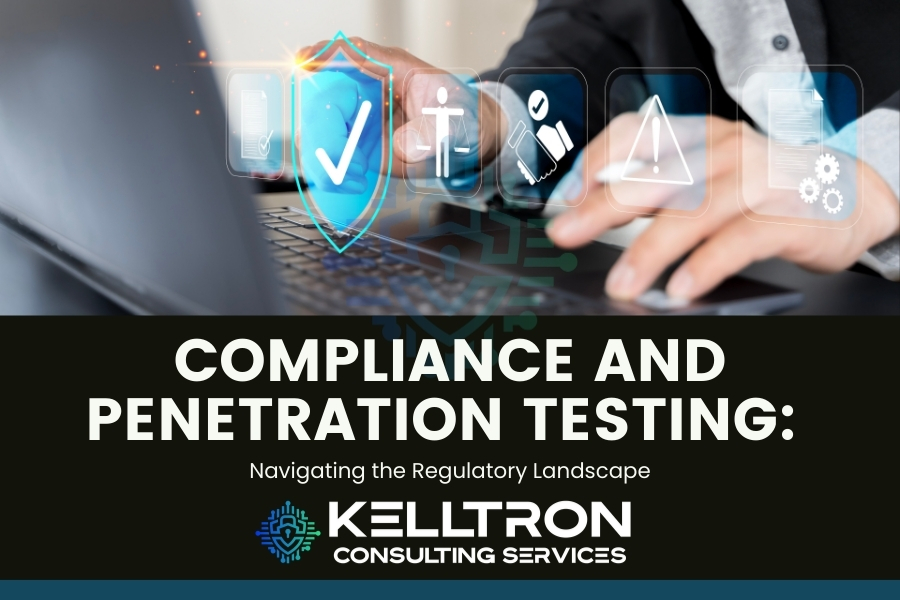Compliance and Penetration Testing: Navigating the Regulatory Landscape - Kelltron Consulting Services
Organizations handling sensitive data or operating in regulated environments must understand the interconnected concepts of compliance and penetration testing. These two elements complement each other in creating a robust security posture, despite serving distinct functions.
Understanding Compliance
Compliance involves adhering to guidelines, norms, or policies established by external entities such as governments or trade associations. These regulations are typically designed to safeguard sensitive data and ensure proper data processing practices. Ensuring compliance with minimum security standards helps mitigate the risks of legal issues, data breaches, and damage to an organization’s reputation.
The Role of Penetration Testing
Penetration testing, conducted by authorized security professionals ("ethical hackers"), simulates real-world cyberattacks to identify vulnerabilities in systems and applications. By employing techniques such as social engineering, network vulnerability scanning, and application exploits, penetration testing can uncover potential data leaks, system disruptions, and unauthorized access points.
The Connection Between Compliance and Penetration Testing
- Compliance Mandates Penetration Testing: Many regulations require regular penetration testing to verify compliance and assess the effectiveness of security controls.
- Penetration Testing Informs Compliance Efforts: The results of penetration tests guide and prioritize remediation efforts, helping organizations achieve and maintain compliance.
- A Unified Approach: While compliance ensures a minimum level of security, regular penetration testing proactively identifies and addresses vulnerabilities beyond regulatory requirements.
Why Is Regulatory Compliance Important?
Protecting Data and Reputation
Regulatory requirements are designed to protect data, incorporating global best practices and addressing emerging threats. Adhering to these regulations helps businesses prevent reputational damage and maintain customer trust.
Safeguarding Against Risks
Compliance addresses core security and safety concerns, such as financial stability, data protection, and environmental impact. Noncompliance can result in severe consequences, including license revocation, hefty fines, or legal action. Maintaining compliance safeguards a company’s financial health and reputation.
Enhancing Operational Efficiency
Compliance ensures uniform standards and ethical practices, creating a level playing field for businesses. It provides a structured framework for internal processes, improving efficiency, consistency, and documentation. Additionally, some regulations promote sustainability and responsible resource management, offering potential green incentives.
Understanding Regulatory Requirements
- Identify Applicable Regulations:
- Determine which laws and regulations apply to your region and industry, such as:
- PCI DSS (Payment Card Industry Data Security Standard)
- HIPAA (Health Insurance Portability and Accountability Act)
- GDPR (General Data Protection Regulation)
- CCPA (California Consumer Privacy Act)
- NYDFS Cybersecurity Regulation (New York Department of Financial Services)
- Determine which laws and regulations apply to your region and industry, such as:
- Analyze Specific Requirements:
- Carefully review the regulations’ specifications regarding vulnerability management and penetration testing.
- Stay Updated:
- Monitor regulatory changes to ensure ongoing compliance.
Planning and Conducting Penetration Tests
- Align with Compliance Objectives: Ensure testing procedures meet organizational and legal requirements.
- Engage Qualified Professionals: Employ experienced penetration testers familiar with relevant regulations.
- Define Scope and Objectives: Clearly outline the assets, systems, and applications to be tested, along with specific evaluation goals.
- Obtain Authorization: Secure necessary approvals, particularly in sensitive environments.
Benefits of Penetration Testing
- Demonstrating Security Efforts: Provides tangible proof of an organization’s proactive measures to identify and address vulnerabilities, showcasing a strong security posture.
- Testing Security Controls: Verifies the effectiveness of security measures in protecting sensitive data and systems, staying ahead of attackers and evolving threats.
- Regulatory Compliance: Supports adherence to standards like ISO 27001, GDPR, PCI DSS, HIPAA, and SOC 2, which recommend or require regular penetration testing.
- Preventing Breaches: Proactively identifies and resolves vulnerabilities before malicious actors can exploit them.
- Building Awareness: Enhances security culture by educating organizations about their security weaknesses.
- Building Trust: Reinforces trust with clients and partners by demonstrating a commitment to data security and compliance.
Best Practices for Compliance and Penetration Testing
- Match Testing to Compliance Requirements: Adjust the scope and frequency of testing to meet specific risk profiles and regulatory needs.
- Hire Experienced Penetration Testers: Engage qualified professionals who follow industry best practices and understand relevant laws.
- Prioritize Critical Assets: Focus on systems and data with the highest business impact and sensitivity.
- Implement Comprehensive Vulnerability Management: Address identified vulnerabilities promptly, incorporating regular testing and monitoring.
- Maintain Detailed Documentation: Keep thorough records of testing results, corrective actions, and compliance status for auditing purposes.
Going Beyond Compliance
- Enhance Security Posture: Use penetration testing insights to develop comprehensive security strategies.
- Consider Automation: Leverage automated penetration testing tools to improve efficiency and coverage, complementing them with human expertise for deeper analysis.
- Review and Update Regularly: Continuously refine your penetration testing strategy to address regulatory changes, emerging threats, and evolving infrastructure.
By integrating compliance and penetration testing, organizations can build a resilient security framework, protect sensitive data, and navigate the complexities of the regulatory landscape effectively.
Author: Vivek Anishetty - Cyber Security Consultant.



